 Backend Development
Backend Development
 Python Tutorial
Python Tutorial
 Three methods to use For loop to traverse Python dictionary (detailed examples)
Three methods to use For loop to traverse Python dictionary (detailed examples)
Three methods to use For loop to traverse Python dictionary (detailed examples)
This article brings you relevant knowledge about python. It mainly introduces three methods on how to use for loop to traverse Python dictionary. Let’s take a look at it together. I hope it will be helpful to everyone. help.
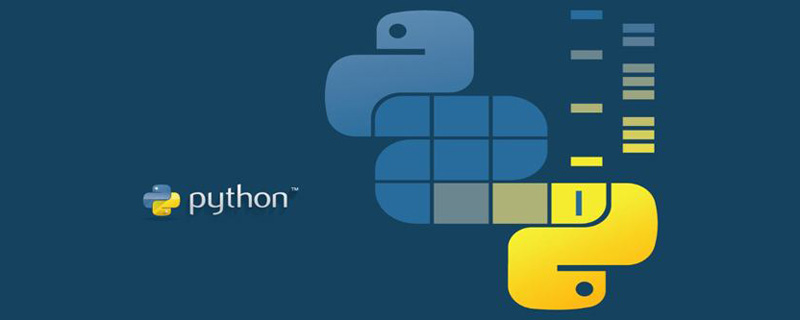
Recommended learning: python video tutorial
In Python, how to use "for" loop to traverse a dictionary?
Today we will demonstrate three methods and learn to traverse nested dictionaries.
Before actual combat, we need to create a dictionary of simulated data.
dict_1 = {'Name': 'Zara', 'Age': 7, 'Class': 'First','Address':'Beijing'}
Method 1: Iterate using For loop index
The easiest way to iterate over a dictionary in Python is to Put directly into the for loop.
Python will automatically treat dict_1 as a dictionary and allow you to iterate over its keys. Then, we can use the index operator to obtain each value.
for key in dict_1: print(key, ":", dict_1[key])
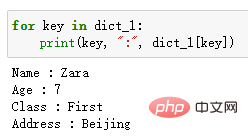
If you want to arrange the keys in alphabetical order, you can use the sorted() method. The specific usage is as follows.
for key in sorted(dict_1): print(key, ":", dict_1[key])
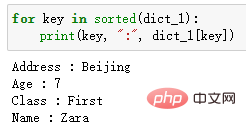
Method 2: Use .keys() index to iterate
Use .keys() to return a Python object containing dictionary keys, you can get Same result as method 1. Likewise, it also needs to be used in conjunction with indexing operators.
for key in dict_1.keys(): print(key, '-->', dict_1[key])
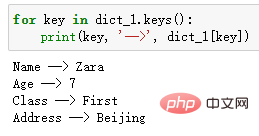
Method 3: Iterate using .items()
In fact, the most "pythonic" and elegant way to traverse a dictionary is The method is to use the .items() method.
print(dict_1.items())

In order to iterate over the keys and values of the transaction_data dictionary, you only need to "unpack" the two items embedded in the tuple, like this:
for k,v in dict_1.items(): print(k,">>",v)
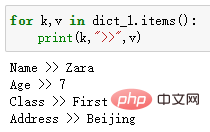
Note that k and v are just standard aliases for "key" and "value", but you can also choose other naming conventions .
For example, we can replace it with a and b, and we will have the same output.
for a,b in dict_1.items(): print(a,"-",b)

Advanced: Traversing nested dictionaries
Sometimes, we will encounter more complex dictionaries-nested dictionary.
So what should we do in this situation?
dict_2 = {"num_1":{'Name': 'Zara', 'Age': 7, 'Class': 'First','Address':'Beijing'},
"num_2":{'Name': 'BOb', 'Age': 32, 'Class': 'Six','Address':'Shanghai'},
"num_3":{'Name': 'Tom', 'Age': 25, 'Class': 'Second','Address':'Wuhan'}}dict_2
In order to unravel the key-value pairs belonging to each nested dictionary, we can do this:
for k, v in dict_2.items(): if type(v) is dict: for nk, nv in v.items(): print(nk, "→", nv)
Determine whether the value is through the if statement Dictionary, if so, use method 3 mentioned earlier, using .items() for iterative output.
The running results are as follows.
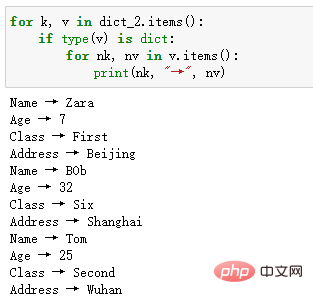
If you only want to decompress part of the dictionary, you can add conditions to the if statement.
for k, v in dict_2.items(): if type(v) is dict and k == 'num_2': for sk, sv in v.items(): print(sk, "-->", sv)
Only outputs the dictionary of num_2. The running results are as follows.
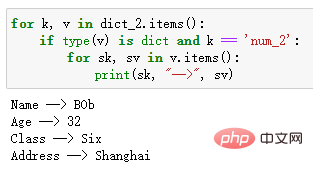
#The above are the tips for using “for” loop to traverse the dictionary in Python.
Recommended learning: python video tutorial
The above is the detailed content of Three methods to use For loop to traverse Python dictionary (detailed examples). For more information, please follow other related articles on the PHP Chinese website!

Hot AI Tools

Undresser.AI Undress
AI-powered app for creating realistic nude photos

AI Clothes Remover
Online AI tool for removing clothes from photos.

Undress AI Tool
Undress images for free

Clothoff.io
AI clothes remover

Video Face Swap
Swap faces in any video effortlessly with our completely free AI face swap tool!

Hot Article

Hot Tools

Notepad++7.3.1
Easy-to-use and free code editor

SublimeText3 Chinese version
Chinese version, very easy to use

Zend Studio 13.0.1
Powerful PHP integrated development environment

Dreamweaver CS6
Visual web development tools

SublimeText3 Mac version
God-level code editing software (SublimeText3)

Hot Topics
 PHP and Python: Different Paradigms Explained
Apr 18, 2025 am 12:26 AM
PHP and Python: Different Paradigms Explained
Apr 18, 2025 am 12:26 AM
PHP is mainly procedural programming, but also supports object-oriented programming (OOP); Python supports a variety of paradigms, including OOP, functional and procedural programming. PHP is suitable for web development, and Python is suitable for a variety of applications such as data analysis and machine learning.
 Choosing Between PHP and Python: A Guide
Apr 18, 2025 am 12:24 AM
Choosing Between PHP and Python: A Guide
Apr 18, 2025 am 12:24 AM
PHP is suitable for web development and rapid prototyping, and Python is suitable for data science and machine learning. 1.PHP is used for dynamic web development, with simple syntax and suitable for rapid development. 2. Python has concise syntax, is suitable for multiple fields, and has a strong library ecosystem.
 PHP and Python: A Deep Dive into Their History
Apr 18, 2025 am 12:25 AM
PHP and Python: A Deep Dive into Their History
Apr 18, 2025 am 12:25 AM
PHP originated in 1994 and was developed by RasmusLerdorf. It was originally used to track website visitors and gradually evolved into a server-side scripting language and was widely used in web development. Python was developed by Guidovan Rossum in the late 1980s and was first released in 1991. It emphasizes code readability and simplicity, and is suitable for scientific computing, data analysis and other fields.
 Python vs. JavaScript: The Learning Curve and Ease of Use
Apr 16, 2025 am 12:12 AM
Python vs. JavaScript: The Learning Curve and Ease of Use
Apr 16, 2025 am 12:12 AM
Python is more suitable for beginners, with a smooth learning curve and concise syntax; JavaScript is suitable for front-end development, with a steep learning curve and flexible syntax. 1. Python syntax is intuitive and suitable for data science and back-end development. 2. JavaScript is flexible and widely used in front-end and server-side programming.
 How to run sublime code python
Apr 16, 2025 am 08:48 AM
How to run sublime code python
Apr 16, 2025 am 08:48 AM
To run Python code in Sublime Text, you need to install the Python plug-in first, then create a .py file and write the code, and finally press Ctrl B to run the code, and the output will be displayed in the console.
 Can vs code run in Windows 8
Apr 15, 2025 pm 07:24 PM
Can vs code run in Windows 8
Apr 15, 2025 pm 07:24 PM
VS Code can run on Windows 8, but the experience may not be great. First make sure the system has been updated to the latest patch, then download the VS Code installation package that matches the system architecture and install it as prompted. After installation, be aware that some extensions may be incompatible with Windows 8 and need to look for alternative extensions or use newer Windows systems in a virtual machine. Install the necessary extensions to check whether they work properly. Although VS Code is feasible on Windows 8, it is recommended to upgrade to a newer Windows system for a better development experience and security.
 Where to write code in vscode
Apr 15, 2025 pm 09:54 PM
Where to write code in vscode
Apr 15, 2025 pm 09:54 PM
Writing code in Visual Studio Code (VSCode) is simple and easy to use. Just install VSCode, create a project, select a language, create a file, write code, save and run it. The advantages of VSCode include cross-platform, free and open source, powerful features, rich extensions, and lightweight and fast.
 Can visual studio code be used in python
Apr 15, 2025 pm 08:18 PM
Can visual studio code be used in python
Apr 15, 2025 pm 08:18 PM
VS Code can be used to write Python and provides many features that make it an ideal tool for developing Python applications. It allows users to: install Python extensions to get functions such as code completion, syntax highlighting, and debugging. Use the debugger to track code step by step, find and fix errors. Integrate Git for version control. Use code formatting tools to maintain code consistency. Use the Linting tool to spot potential problems ahead of time.





